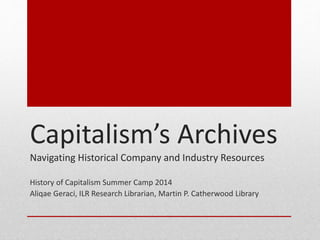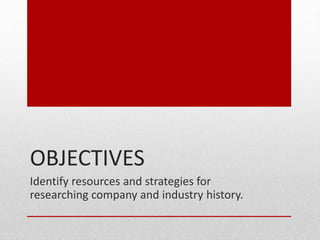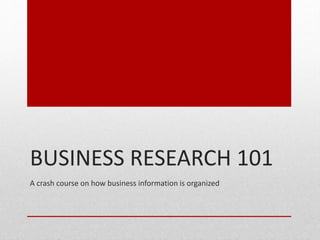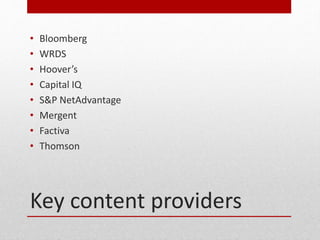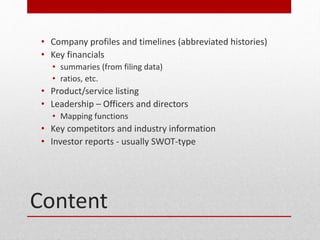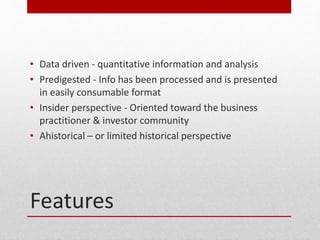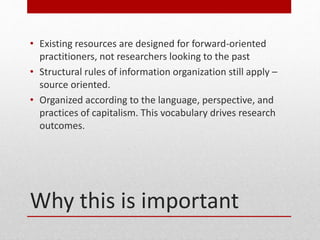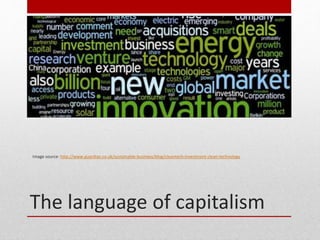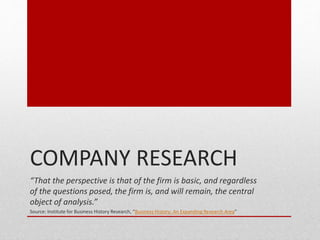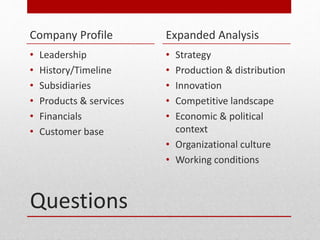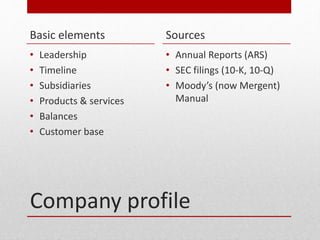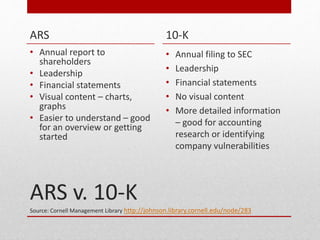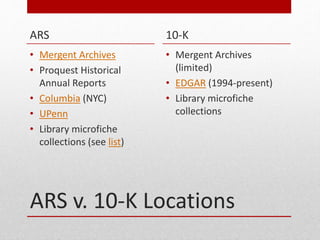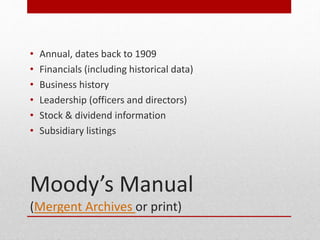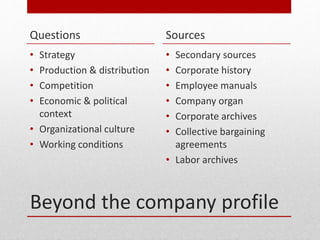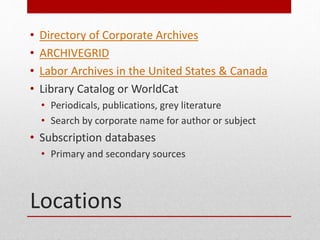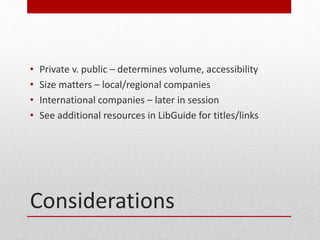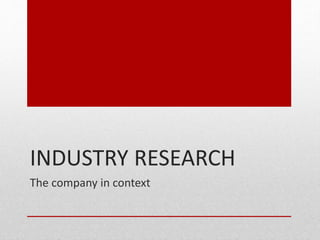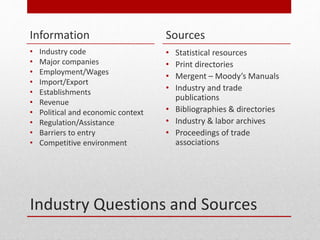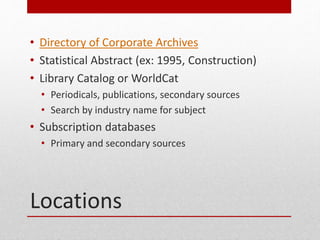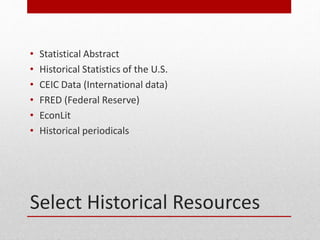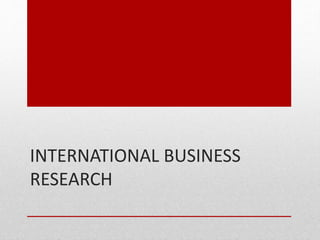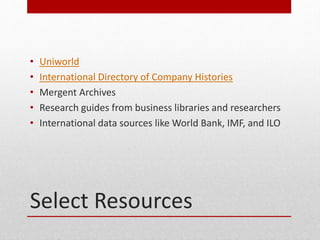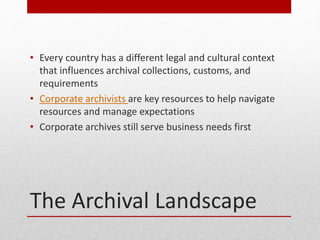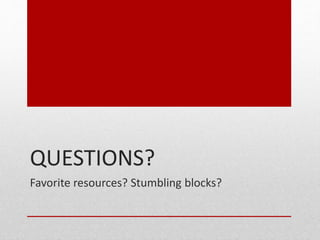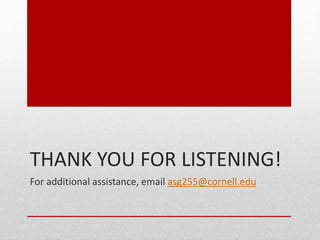Capitalism's Archives: Navigating Historical Company and Industry Resources
- 1. CapitalismĄŊs Archives Navigating Historical Company and Industry Resources History of Capitalism Summer Camp 2014 Aliqae Geraci, ILR Research Librarian, Martin P. Catherwood Library
- 2. OBJECTIVES Identify resources and strategies for researching company and industry history.
- 3. BUSINESS RESEARCH 101 A crash course on how business information is organized
- 4. Key content providers ? Bloomberg ? WRDS ? HooverĄŊs ? Capital IQ ? S&P NetAdvantage ? Mergent ? Factiva ? Thomson
- 5. Content ? Company profiles and timelines (abbreviated histories) ? Key financials ? summaries (from filing data) ? ratios, etc. ? Product/service listing ? Leadership ĻC Officers and directors ? Mapping functions ? Key competitors and industry information ? Investor reports - usually SWOT-type
- 6. Features ? Data driven - quantitative information and analysis ? Predigested - Info has been processed and is presented in easily consumable format ? Insider perspective - Oriented toward the business practitioner & investor community ? Ahistorical ĻC or limited historical perspective
- 7. Why this is important ? Existing resources are designed for forward-oriented practitioners, not researchers looking to the past ? Structural rules of information organization still apply ĻC source oriented. ? Organized according to the language, perspective, and practices of capitalism. This vocabulary drives research outcomes.
- 8. The language of capitalism Image source: http://www.guardian.co.uk/sustainable-business/blog/cleantech-investment-clean-technology
- 9. COMPANY RESEARCH Ą°That the perspective is that of the firm is basic, and regardless of the questions posed, the firm is, and will remain, the central object of analysis.Ąą Source: Institute for Business History Research, Ą°Business History: An Expanding Research AreaĄą
- 10. Questions Company Profile ? Leadership ? History/Timeline ? Subsidiaries ? Products & services ? Financials ? Customer base Expanded Analysis ? Strategy ? Production & distribution ? Innovation ? Competitive landscape ? Economic & political context ? Organizational culture ? Working conditions
- 11. Company profile Basic elements ? Leadership ? Timeline ? Subsidiaries ? Products & services ? Balances ? Customer base Sources ? Annual Reports (ARS) ? SEC filings (10-K, 10-Q) ? MoodyĄŊs (now Mergent) Manual
- 12. ARS v. 10-K Source: Cornell Management Library http://johnson.library.cornell.edu/node/283 ARS ? Annual report to shareholders ? Leadership ? Financial statements ? Visual content ĻC charts, graphs ? Easier to understand ĻC good for an overview or getting started 10-K ? Annual filing to SEC ? Leadership ? Financial statements ? No visual content ? More detailed information ĻC good for accounting research or identifying company vulnerabilities
- 13. ARS v. 10-K Locations ARS ? Mergent Archives ? Proquest Historical Annual Reports ? Columbia (NYC) ? UPenn ? Library microfiche collections (see list) 10-K ? Mergent Archives (limited) ? EDGAR (1994-present) ? Library microfiche collections
- 14. MoodyĄŊs Manual (Mergent Archives or print) ? Annual, dates back to 1909 ? Financials (including historical data) ? Business history ? Leadership (officers and directors) ? Stock & dividend information ? Subsidiary listings
- 15. Beyond the company profile Questions ? Strategy ? Production & distribution ? Competition ? Economic & political context ? Organizational culture ? Working conditions Sources ? Secondary sources ? Corporate history ? Employee manuals ? Company organ ? Corporate archives ? Collective bargaining agreements ? Labor archives
- 16. Locations ? Directory of Corporate Archives ? ARCHIVEGRID ? Labor Archives in the United States & Canada ? Library Catalog or WorldCat ? Periodicals, publications, grey literature ? Search by corporate name for author or subject ? Subscription databases ? Primary and secondary sources
- 17. Considerations ? Private v. public ĻC determines volume, accessibility ? Size matters ĻC local/regional companies ? International companies ĻC later in session ? See additional resources in LibGuide for titles/links
- 18. INDUSTRY RESEARCH The company in context
- 19. Industry Questions and Sources Information ? Industry code ? Major companies ? Employment/Wages ? Import/Export ? Establishments ? Revenue ? Political and economic context ? Regulation/Assistance ? Barriers to entry ? Competitive environment Sources ? Statistical resources ? Print directories ? Mergent ĻC MoodyĄŊs Manuals ? Industry and trade publications ? Bibliographies & directories ? Industry & labor archives ? Proceedings of trade associations
- 20. Locations ? Directory of Corporate Archives ? Statistical Abstract (ex: 1995, Construction) ? Library Catalog or WorldCat ? Periodicals, publications, secondary sources ? Search by industry name for subject ? Subscription databases ? Primary and secondary sources
- 21. MACROECONOMIC RESEARCH Stay in Ą°Industry & Macroeconomic ResearchĄą
- 22. Select Historical Resources ? Statistical Abstract ? Historical Statistics of the U.S. ? CEIC Data (International data) ? FRED (Federal Reserve) ? EconLit ? Historical periodicals
- 24. Select Resources ? Uniworld ? International Directory of Company Histories ? Mergent Archives ? Research guides from business libraries and researchers ? International data sources like World Bank, IMF, and ILO
- 25. The Archival Landscape ? Every country has a different legal and cultural context that influences archival collections, customs, and requirements ? Corporate archivists are key resources to help navigate resources and manage expectations ? Corporate archives still serve business needs first
- 26. QUESTIONS? Favorite resources? Stumbling blocks?
- 27. THANK YOU FOR LISTENING! For additional assistance, email asg255@cornell.edu
Editor's Notes
- #11: Basic company profile content ĻC or, known item queries. Vs. open ended queries requiring subjective analysis.

